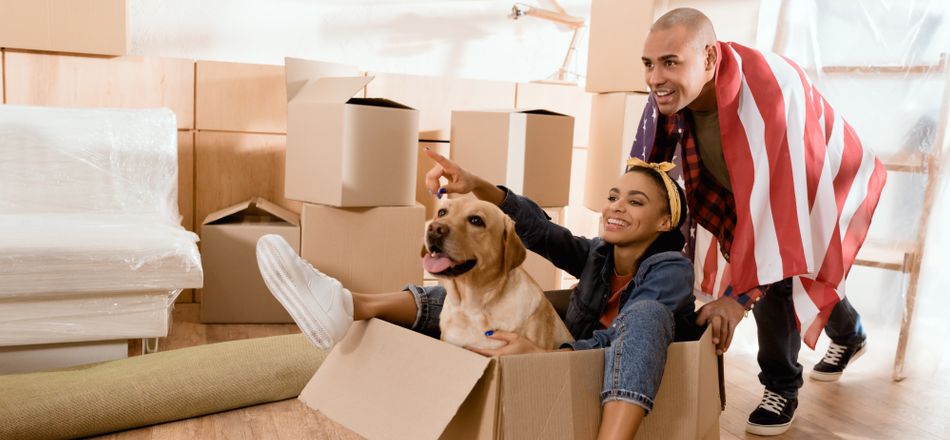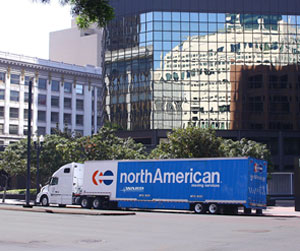
Moving can be stressful for every member of your family, but especially for your pet, who does not understand what is happening.
The change and upheaval associated with moving can cause distress in your animals, particularly if they pick up on the fact that you are stressed or sad about the move.
While you cannot entirely eliminate the stress of moving, you can take steps to make the process of house packing with pets easier.
If you want to know how to handle moving with a pet, try the tips below. They cover every stage of the moving process, from packing up your house to settling in at the new location.
Before the Move

Prep your animal for the move
Chances are you see a move coming from weeks or months away. Even in the rare instance that you only have a few days to relocate, you can take steps to help your pet feel calm and safe during the transition.
☑ Educate yourself on your new location
Before you travel to a new residence, you want to make sure that the new spot will work for your furry (or scaled, or feathered) friend. To that end, educate yourself about the following aspects of your new location before you move.
- State and local regulations regarding your animal
- Pet friendliness of your apartment or neighborhood
- Location of walking trails and dog parks
- Breed restrictions for your area
- Pet fees
- Potential hazards (such as aggressive neighborhood dogs)
- Location of vets, emergency clinics, trainers, and other professionals.
Make sure you are prepared to deal with any regulations, hazards, or restrictions that come with your new location.
If you are able, you should also look for a place that has the pet-friendly features you want, such as a fenced-in backyard, ground-level apartment (for ease of toileting, particularly older animals), or nearby walking trails and dog parks.
☑ Prep your animal for the move
There are also a few things you need to do to get your animal ready for the big day. Try to accomplish these tasks early so you don’t have to do them in the chaos of the move.
- Update their microchip or tag information with your new information
- Obtain your pet’s records and medications from your current vet
- Take your pet to the vet to get a checkup and any necessary vaccines
☑ Plan your road trip
Unless you are hiring a service to take your pet to your new home for you, chances are they are going with you in the car.
If you wonder how do you move long distance with a pet, then you are already thinking about how to make that road trip comfortable for everyone. The best approach is to plan ahead.
- Call hotels where you plan to stop to make sure the ones you choose are pet friendly for your pet.
- Plan where to stop to get gas and food so you know there are places where you can eat with your pet.
- Know how you will restrain your animal in the car.
☑ Pick up your moving supplies early
Preparing for a move requires many items that may be unfamiliar to your pet. Before you begin packing, give your animal the chance to grow accustomed to strange new objects like bubble wrap, boxes, and packing tape.
Pick up your supplies early and leave them in your house for at least a few days before you begin using them. Encourage your animal to sniff and explore the materials. Just make sure you supervise any explorations, since you don’t want boxes falling on your animal and you don’t want them chewing on bubble wrap.
While Packing

Stay calm so your pet stays calm
House packing with pets presents its own challenges that you can overcome with a little planning and creativity.
☑ Stay calm so your pet stays calm
Pets are very good at picking up on your stress level. In order to minimize distress for your pet, try to remain calm and positive about the move yourself.
☑ Pack the essentials for your pet
During the move and the first few days after the move, things are likely to be hectic and you may not have immediate access to all of your things.
In order to maintain access to your pet’s most important belongings, pack the essentials to accompany you on your trip to your new place (DO NOT put them on the moving truck).
Pack these essentials:
- Bed or blanket
- Medications
- Vet records
- Favorite toys
- Food
- Water and food bowls
- Kitty litter
- Grooming tools
- Anything else your dog requires on a daily basis
Not only will this “go bag” keep all of your animal’s important things within reach, but having those things around will help to calm and reassure your pet during the move.
☑ Give your pet a place to relax during packing
Watching their home turned upside down by packing can be very stressful for an animal. In order to help them relax, consider giving them a quiet place to stay while you pack.
For example, ask a friend or family member to watch them for a day or an evening while you get things done. Consider sending them to a boarder they are comfortable with. You can even set them up in a separate room of the house with their bed, food, water, and toys.
An added bonus of having your animal somewhere else while you pack is that you can focus on the tasks at hand instead of having to worry about taking care of your pet or worrying about what your animal might be getting into.
☑ Maintain your pet’s routine
If there is one constant about moving, it is that regular routines become upended. In the chaos of moving prep, however, the best thing you can do for your pet is to maintain their schedule.
Animals tend to prefer and to take comfort in routine. Feeding them, walking them, playing with them, letting them outside, and more at the same times, and for the same amount of time, as usual can help them feel more confident in the changes happening around them.
If you cannot devote the same amount of time as usual to keeping their schedule intact, consider asking family and friends or hiring someone to take over some of those tasks for you while you prepare for your move.
☑ Get your pet used to their crate
If you are moving with a dog or a cat, chances are they will need to travel in a crate, or stay in a crate on moving day.
If your animal isn’t already accustomed to the crate, you should acclimate them to it in the weeks leading up to the move. The more comfortable they are with the crate, the less anxious they will be when moving day comes.
Gradual introduction is the best approach. Try these steps to get your furry friend used to their kennel:
- Put food inside the open crate.
- Reward them with playtime and treats every time they use the crate.
- Work up to having them eating in the crate with the door closed.
- Take them for drives in the crate.
☑ Make house packing with pets fun
Packing your house up may feel like drudgery, but you can inject some fun into the process, and keep your pet happy, by turning the process into a game.
For example, hide your pet’s toys or treats and let them go hunting. Buy a treat puzzle or Kong (for a dog) and let them play with it.
Even though packing may take up most of your time, also be sure to take breaks to play with your pet. Even 5 minutes at a time spent focused on your furry (scaled, or feathered) friend can help both of you bond and recharge for the next round of packing.
Keeping your pet busy and entertained will keep them out of your way while you pack, as well as helping both them and you relax.
☑ Use anxiety aids if necessary
If you know that your pet is high-strung, or if they begin to show signs of anxiety while you are packing, consider using anxiety aids to help them calm down.
Anxiety aids can include anything from over the counter and prescribed medication to Thundershirts, calming collars, and more.
Your vet can provide resources and insights into what might work best for your pet. Using these aids while house packing with pets can also help you determine what will work best to keep your animal calm on moving day and during the trip to your new home.
During the Move

What do you do with pets on moving day?
What do you do with pets on moving day? The best approach is to put them in a quiet room of your home with their favorite bedding and toys, along with food and water. Close the door and put a sign on it so movers do not disturb your pet. Then, pack up that room last when you are ready to put your pet in the car.
When you do put your pet in the car and begin your journey, try the following tips to keep them calm and happy on the way:
☑ Keep them restrained in the car
Using a crate, carrier, or specialized bird cage can keep your pet restrained in the car, both to keep them calm and to keep them safe. Make sure never to open the crate, carrier or cage until your pet is inside your new home. Otherwise, they may bolt, and you could end up looking for your precious family member instead of completing your move.
You should also never put your pet in the moving truck. Their crate or carrier will not be restrained there, and they could slide around and get injured. There is also a greater chance that boxes will fall on them or that they will suffer distress at being away from you in a frightening and unfamiliar environment. Keep them with you during the move, or hire professionals to accompany them to your new home.
☑ Don’t feed them too soon before the trip
Your pet should have plenty of access to water at all times. However, you may want to feed them a few hours before you begin your trip. Doing so can prevent them from getting sick on the trip.
☑ Keep familiar items with them
Do not buy new items for the trip or for the first few weeks in your new home. Their old beds and toys will be comforting to them during the move and as they settle in. You can, however, spring for new treats to eat on the way.
After the Move

Set your pet up in one room of the house
Knowing how to handle moving with a pet includes knowing how to help them settle in. The length of time it takes your dog or other pet to get used to their new home depends on them. Some will be comfortable within a matter of days, while others will take weeks or months.
There are a few steps you can take to ensure a smoother transition for your beloved animal.
☑ Check your new home for hazards
Before allowing your pet inside your new home, check for potential hazards. Chemicals, cords, and other items may be dangerous to your pet. Once you pet proof your new space, then you can welcome your pet into their new home.
☑ Set them up in one room of the house
Rather than asking your pet to familiarize themselves with the entire house at once, set them up in one room of the house. Try to unpack this room before you put them in it so it is calm and comfortable and familiar.
Allowing your pet to remain in this room for a few days can help them to acclimate to their new space without getting overwhelmed. Be sure to make the space a comfortable and fun area by playing with them there and putting all of their familiar items in there with them.
After they are happy in the new room, gradually allow them to explore other areas of the house. Soon enough, they will know that they are home.
When house packing with pets and then moving with them, the most important gift you can give them is patience, and attention. Knowing that you are happy and engaged with them can keep them calm and happy, too. As long as you are patient and upbeat and take the time to make them comfortable, they will quickly adjust to their new space with their favorite person: You!





